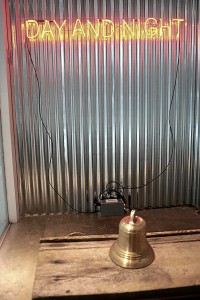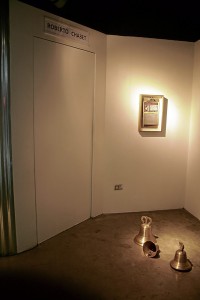 “Day And Night,” ongoing in Paseo Gallery (4/F, SM Megamall), appears to be a blow-up to beyond-life proportions of the Cornellian Box and its “shadows of forgotten dreams.”
“Day And Night,” ongoing in Paseo Gallery (4/F, SM Megamall), appears to be a blow-up to beyond-life proportions of the Cornellian Box and its “shadows of forgotten dreams.”
Its host of meanings and memories, anachronistic and synchronous, highly sentimental and romantic, objectifies “a greater personal mythology.” Objects in itself, objects representing memories, an entire tableau as the vehicle of a memory, or just bits of memory in itself that are the small epiphanies that make up consciousness, are culled from a repository, and for what? Obviously for itself, like Yeats’ “Nor is there singing in school but studying, monuments of its own magnificence.”
And in the interpretive, the use of material objects carry the load of meanings that are misleading, in the Baudrillard sense, in various “signs” in emphasized disconnection, that want and prey on the need for “discourse” in order to be demystified.
The nature of Chabet’s objects goes through the regurgitation of attached meaning and re-meaning, but not in total non-meaning. Actual objects from their contexts of origination are kept, and later unburdened of its original functions, and assume a narrative or a signifier role.
Back to Baudrillard’s allusion of the soldier’s meeting with Death via a misread sign at the marketplace, a series of signs loses its meaning but finds restitution in a place of destiny, or, in the case of signs, to be recovered in discourse, “all meaningful discourse seeks to end appearances,” vis-a-vis “any system that is totally complicit in its own absorption, such that signs no longer makes sense, will exercise a remarkable power of fascination.”
A silent indiscretion for Chabet and hardly looked at and not at all an over read, is that Chabet is quietly political. This goes against the grain of an espoused purity, befittingly falling under early Greenbergian discussions on the avant-garde and its strategies to survive and exist.
It is also obvious to assume Chabet and his industry as a system in Philippine context will fit this classification, but not late Greenbergian tenets of championing the flat plane and an ever-pressing move for inwardness, won over by the cynicism and further rethinking of art posed by Pop Art, Minimalism and Conceptual Art.
Minimalist
In the year-long survey of Chabet celebrating 50 years of his groundbreaking artistic practice, Chabet’s exhibition in Finale Art Gallery, “Onethingafteranother,” references the Minimalists, specifically the sculptor and painter Donald Judd, already an artistic political force that changed perceptions and viewpoints of what will, in finality, constitute art.
 In Lisa Ito’s notes, Chabet’s appropriation of the Judd’s text “Onethingafteranother” and subsequent installation piece is highly politicized and political of, as something didactic in its timeliness and timelessness in being re-represented today, “Onethingafteranother” reverberates into the present. Decades after, it is still a statement that captures the menacing hyper reality of the current period, in this time of mass destruction on a global scale, the bombardment of images through technology, the systematic production of illusions, decoys, one after another, one over and over. There are disturbing signs of the times: topographies of transience.
In Lisa Ito’s notes, Chabet’s appropriation of the Judd’s text “Onethingafteranother” and subsequent installation piece is highly politicized and political of, as something didactic in its timeliness and timelessness in being re-represented today, “Onethingafteranother” reverberates into the present. Decades after, it is still a statement that captures the menacing hyper reality of the current period, in this time of mass destruction on a global scale, the bombardment of images through technology, the systematic production of illusions, decoys, one after another, one over and over. There are disturbing signs of the times: topographies of transience.
Chabet is the constant arbiter of kitsch and the avant-garde, uncompromisingly distilling each one from the other. These two strains, again for Greenberg, find the necessity for each in order to exist, but where does one draw the line?
In Chabet’s covert politics, the natural orientation of the school desks placed on the floor in the “Day and Night” tableau orients a gravity-based room, connected in their disconnectedness in its signs and symbols inhabiting. The situation of location of this tableau has been carefully considered, a hall at the heart of city’s district of commerce.
A total encasement of glass that enables no privacy, the shimmer of the accordion of curves from the GI sheets-lined walls, suggests the panoptical cell, almost Kafkaesque in its sublime morbidity and calm quasi-technological specifications, always under surveillance. But who is on trial this time? The looked at, as often is the case, or the audience looking? Who is being looked at this time and weighed?
A sitting duck and a moving target to a host of misunderstandings, the goat is always gutted at its peripherals. Why not meet the matter head on? The piñata is certainly on the head of the pony that makes the wisecracks and assesses in his mind a figure as already “categorized,” but failing to realize the involvement and regurgitation in the work. Sure, at some point, some lows are hit, and aren’t we prone to such creative fits?
A man must be weighed as he is against himself. According to his follies and laurels, as we all, too, do have. By just being there, it is a political standard that is the measure, and once and for all, fulfills the duty of guardian and beacon. It is necessary for our time, one of a few remaining strands of the pure, for all art to live on.
Conjectural, interpretive
 In the conjectural sense, the meanings in the tableau makes it open to be read and the signs in the scenario are willing to question interpretation. A José Rizal slate is sentimental enough. It is a deliberate inclusion in an otherwise aesthetically made tableau based on detachment.
In the conjectural sense, the meanings in the tableau makes it open to be read and the signs in the scenario are willing to question interpretation. A José Rizal slate is sentimental enough. It is a deliberate inclusion in an otherwise aesthetically made tableau based on detachment.
What meaning does it hold for Chabet and the interpretation-happy viewer? Is Chabet the intellectual hero resorting to filibuster in agitating the end of days of a delayed revolution? In melancholic gloom watching and waiting on a historic river from the top of a perch, alluded by the Lopez Museum exhibition “Tabo,” watching for the dead man to awaken from his hiding in the watery depths? Is the writing slate a signifier of sweet surrender to the erasure of a history? Is it guilt of an American past and trappings of a Western canon of painting?
The work is noncommittal, but it also wants to take part. And if it does so, it must be in the industry of the avant-garde with the proper dispensation of the muse.
No artist of his generation has postulated such demanding commentaries on our situation as Chabet has, sifting through the debris of colonial culture clashes in the form of a private storytelling that is poetic, moving and literate. In doing so, Chabet has lent his vision of a developing avant-garde from which to measure and follow.
Jonathan Olazo is an artist and teacher. A former student of Chabet, he lectures at the University of the Philippines College of Fine Arts.














































